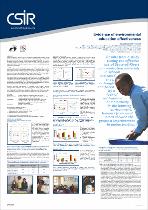JavaScript is disabled for your browser. Some features of this site may not work without it.
- ResearchSpace
- →
- Research Publications/Outputs
- →
- Conference Publications
- →
- View Item
| dc.contributor.author |
Strydom, WF

|
|
| dc.contributor.author |
Esler, KJ

|
|
| dc.date.accessioned | 2008-12-08T14:46:24Z | |
| dc.date.available | 2008-12-08T14:46:24Z | |
| dc.date.issued | 2008-11 | |
| dc.identifier.citation | Strydom, WF and Esler, KJ. 2008. Evidence of environmental education effectiveness. Science Real & Relevant: 2nd CSIR Biennial Conference, CSIR International Convention Centre Pretoria, 17 & 18 November 2008, pp 1 | en |
| dc.identifier.uri | http://hdl.handle.net/10204/2684 | |
| dc.description | Science Real & Relevant: 2nd CSIR Biennial Conference, CSIR International Convention Centre Pretoria, 17 & 18 November 2008 | en |
| dc.description.abstract | A 2007 study in randomly-selected schools in the Buffalo (group B), Hartenbos and Klein Brak (group H) catchments determined how effectively State-of-Rivers (SoR) communication materials had been used in the education system of grades 1 to 3. Questionnaires and participatory evaluation techniques were used to determine the level of understanding of human impacts on rivires, both before learners had seen the materials and after esposure to materials. | en |
| dc.language.iso | en | en |
| dc.subject | State-of Rivers (SoR) communications | en |
| dc.title | Evidence of environmental education effectiveness | en |
| dc.type | Conference Presentation | en |
| dc.identifier.apacitation | Strydom, W., & Esler, K. (2008). Evidence of environmental education effectiveness. http://hdl.handle.net/10204/2684 | en_ZA |
| dc.identifier.chicagocitation | Strydom, WF, and KJ Esler. "Evidence of environmental education effectiveness." (2008): http://hdl.handle.net/10204/2684 | en_ZA |
| dc.identifier.vancouvercitation | Strydom W, Esler K, Evidence of environmental education effectiveness; 2008. http://hdl.handle.net/10204/2684 . | en_ZA |
| dc.identifier.ris | TY - Conference Presentation AU - Strydom, WF AU - Esler, KJ AB - A 2007 study in randomly-selected schools in the Buffalo (group B), Hartenbos and Klein Brak (group H) catchments determined how effectively State-of-Rivers (SoR) communication materials had been used in the education system of grades 1 to 3. Questionnaires and participatory evaluation techniques were used to determine the level of understanding of human impacts on rivires, both before learners had seen the materials and after esposure to materials. DA - 2008-11 DB - ResearchSpace DP - CSIR KW - State-of Rivers (SoR) communications LK - https://researchspace.csir.co.za PY - 2008 T1 - Evidence of environmental education effectiveness TI - Evidence of environmental education effectiveness UR - http://hdl.handle.net/10204/2684 ER - | en_ZA |






